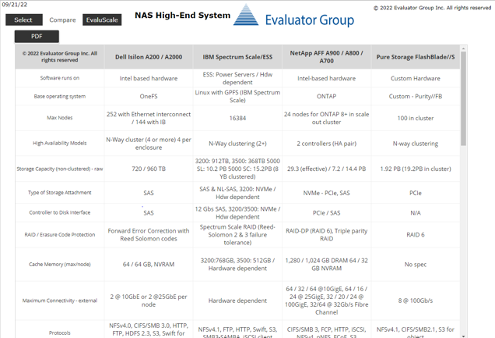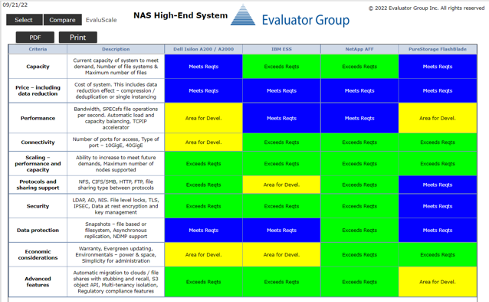This website uses cookies so that we can provide you with the best user experience possible. Cookie information is stored in your browser and performs functions such as recognising you when you return to our website and helping our team to understand which sections of the website you find most interesting and useful.
This is Part 5 of this blog series. Read Part 4 here.
This is the fifth installment in a series about considerations for IT in changing storage vendors and storage systems. Changing storage vendors is a decision that is not taken without careful consideration by IT professionals and has significant implications. This series examines the evaluation of vendor storage solutions as part of the decision to change storage vendors.
Part 4 gave considerations for evaluating a block storage solution in addition to the common storage evaluation elements in part 3. The common elements and the criteria for evaluation were explained for block, file, and object access methods. This part will deal with specifics for NAS file storage evaluation.
Evaluating a NAS – Network Attached Storage Solution
File storage has a number of different possible solutions for Information Technology operations. They range from the common file system on a server to scale out parallel file systems used in high performance computing. The predominant answer for IT has been NAS systems for shared, centralized storage. When changing a storage vendor, a change in NAS systems may also be included. That change would initially seem to be simple; the access of files using NFS or SMB is standard and file shares are mounted for servers. There are differences in systems, primarily in the advanced features and data services offered by vendors as differentiators for those systems. The high value features are utilized to improve operations and data protection. The differences require an evaluation of a NAS system and an understanding of changed operational practices and their impact when a different system is acquired.
Valuable Information to Aid in Evaluation
The Evaluator Group has extensive information regarding different storage solutions including product analysis, comparative information, evaluation guides and the Evaluation Group analyst opinions about how well product meet criteria. A short description, example, and link to these areas on the Evaluator Group website should be useful. The material is updated as new product updates (and new products) are released.
There is also the opportunity to change how file storage is delivered when the storage vendor is changed. A Global File System solution may be used for example. Evaluator Group has information on Global File Systems and decisions:
- Global File Systems Help Overcome Cloud Challenges (evaluatorgroup.com)
- File Storage Selection – NAS vs Global File Systems (evaluatorgroup.com)
In addition to alternative solutions for Global File Systems information, a NAS Evaluation Guide is available:
NAS Evaluation Guide | Evaluator Group
In the case of high-performance requirements, there is also an evaluation guide for Scale-out File Systems:
Scale-out File System Evaluation Guide | Evaluator Group
Product analysis of the individual solutions in the different areas noted above are also available to subscribers of the Evaluator Group research information.
Comparison Matrices
Comparison matrices provide information that is useful in a side-by-side format. There are matrices in two forms: one that is a PDF with comparison of products (in this case, NAS storage systems) in a category such as high-end NAS storage systems and another is an interactive comparison matrix where up to four products may be compared against each other. A shortened sample of the interactive matrix follows:
The analyst opinions as to meeting criteria is in the EvaluScale matrix. A sample follows:
Both the interactive and EvaluScale matrices require a subscription.
Evaluation Consideration for NAS Storage (not included in the Common Considerations in Part 3)
File Access Protocols
NFS and SMB(CIFS) seem ubiquitous and are from the standpoint of almost all NAS systems support the protocols for access. There are differences in the versions of each that are meaningful. NFS is currently at version 4.2 but many of the NAS systems only support up to version 3. The detail differences are beyond the scope of this article but a major difference is that version 3 only supports advisory level locking of files meaning that an open file could potentially be overwritten if more than one application is accessing the file.
For SMB, there are two types of implementations: a native implementation and an implementation that attempts to mimic the operation of the Microsoft native implementation. The second type is called SAMBA and does has some variations in the way that permission inheritance is handled. Native implementations by different vendors can have some variation in implementation but, to date, these have been minor.
When changing storage vendors and NAS storage systems, it will be important to understand what is in current use and what the new/replacement system supports. Subtle differences can cause problems that may be difficult to determine and to overcome.
Data Migration
Introduction of a different or new NAS system introduces the challenge of moving files to the new system and, in most environments, doing it without disruption. There are a number of independent software products to aid in migrations and some of the NAS system vendors partner with them as part of a deployment. Some products also have the migration as a built-in capability. Usually these require re-pointing the file share to the new system. These are necessary and valuable capabilities but do require an understanding as part of an evaluation of a NAS system being introduced into an existing environment.
Advanced Features
Some advanced features that are specific to NAS storage in their implementation need to be considered. One that has proven to be highly valuable is a system feature to move inactive files to S3 object storage based on policies – on-premises or in a public cloud. Implementations vary a great deal and need to be thoroughly examined. These can have significant value in delaying the need to purchase additional capacity by tiering off inactive data.
A related feature is the ability to make a copy of data and send it to S3 storage as a disaster recovery copy. The operational mechanism is similar, if not the same, as tiering but the usage and control is different. This again is a valuable feature for data protection.
Immutable copies of data and support for versioning with retention periods are characterized as security features for NAS systems. These have operational value as well. There is a wide variation of implementation for the NAS systems that have these capabilities. The security capabilities have risen to be a major functionality for consideration.
These are some of the major evaluation considerations for NAS storage systems when combined with the common elements brought out in Part 3. There are others that can be investigated through the links provided as well as the Evaluator Group product analysis.
Part 6 in this series will look at some specifics in evaluating Object Storage. Characteristics for evaluation and information sources to obtain information will be included.


